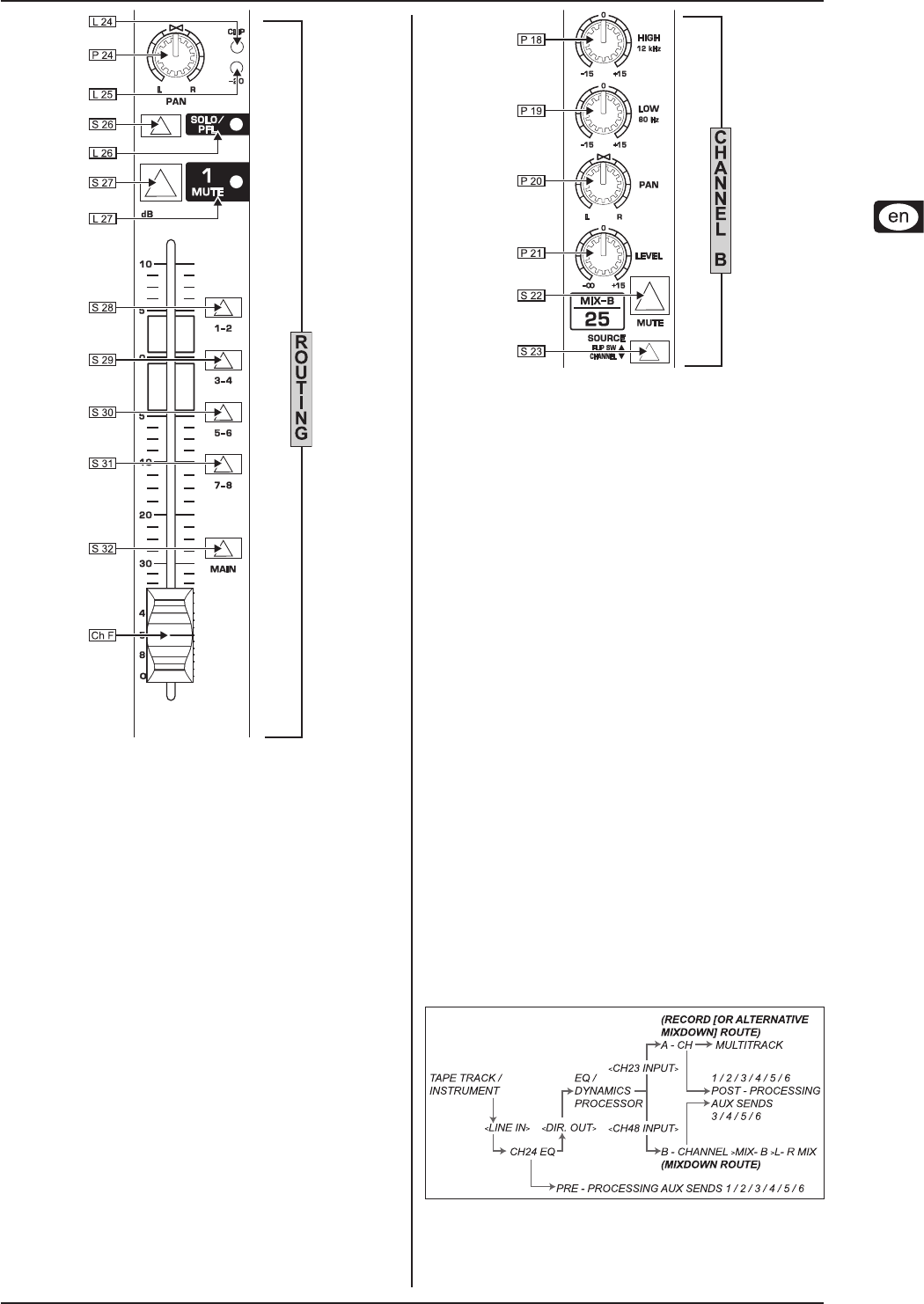
EURODESK SX4882
Inserts 7
RoutingFig. 3.5:
The level to the subgroup and main mix buses is ultimately deter-
mined by the channel faders. These are designed to give a smooth
logarithmic taper of a type more usually associated with the name
of some pretty expensive brand ... The low level performance
particularly is far smoother than that of a normal “budget” fader.
The MUTE button (S27), like that for SOLO has an LED indicator
(L27) and removes the A-channel signal from all buses, save any
auxes set to pre fader. It is ergonomically placed immediately
above the fader and engaging MUTE is equivalent to setting a
fader level of minus innity.
B-channel3.7
The B-channel (g. 3.6) comprises a secondary channel with its
own high and low EQ, pan and level (P18, P19, P20 and P21).
The EQ is a replica of the A-channel shelving EQ. The B-channel
ALWAYS feeds into the MIX-B stereo bus, but its source can be
switched between TAPE, LINE, MIC and A-CHANNEL, depend-
ing on how S1, S3 and S23 are set (see g. 3.2 and section 3.2).
Unusually for an 8-bus console, B-channels also have their own
MUTE buttons (S22). Aux sends 3/4/5/6 may be diverted from the
A to the B-channel via S17. Therefore, if the B-channel is being
used to monitor off-tape, some FX processing e.g. reverb and echo
can still be applied. (See section 16.3 “Wet monitoring”.)
When B-channel looks at A-channel (S23 DOWN), the +
signal comes A-channel mute switch and pre fader. A
modication can convert this PRE stereo aux send to
POST fader. (See 23.2 “MIX-B source > post fader”.)
B-channelFig. 3.6:
Inserts4.
Insert points are useful for adding dynamic processing or equal-
ization to a channel, subgroup or the mix. Unlike reverbs, etc.,
which are usually added to the dry signal, dynamic processing is
normally applied across an entire signal. Here, an aux send would
be inappropriate. Instead the signal is intercepted somewhere
along the channel/subgroup/mix, fed through the dynamics pro-
cessor and/or EQ and then returned to the console at the same
point where it left. The insert point is invisible or normalized, until
a jack is plugged into it.
All subgroups and channels have got insert points, as does the
main stereo output. Both SEND and RETURN are accommodated
on a single stereo 1/4" jack socket wired tip=send, ring=return.
Inserts are always pre fader and also pre EQ / aux sends for
channels.
Insert points may also be used as pre EQ direct outputs without
interrupting the signal ow. This is obvious when looking at the
patchbay wiring (section 8, g. 8.1). If you want to insert a dynamics
processor post EQ, the insert point must either be taken from a
subgroup, or via a second channel / aux return as follows:
Insert a compressor/gate/EQ across a subgroup, and route 1)
the channel to be processed (and only that channel) to that
subgroup.
Alternatively, patch a channel’s direct out into a compressor/2)
gate/EQ. Take the output from that compressor/gate/EQ and
feed it back into the desk via a secondary input (channel,
aux return, etc.).
Figure 4.1 illustrates how you might insert into a channel post
EQ for mixdown or track-laying (their requirements are different).
Mixdown requires one A and one B-channel. Recording requires
two A-channels.
Post EQ channel insertFig. 4.3:


















